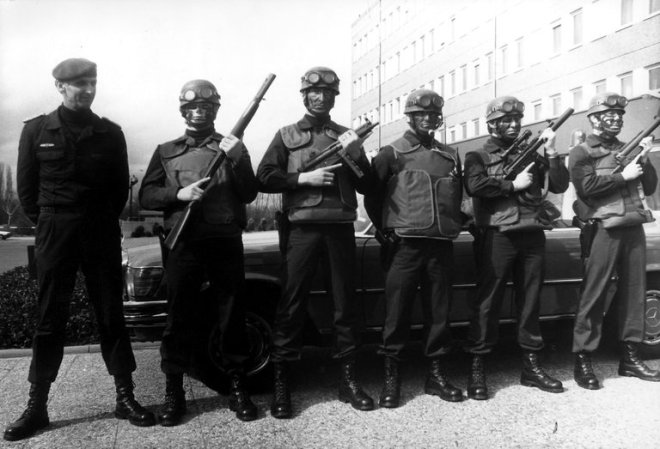
Thursday January 4, 2018

Ulrich Wegener, left, in 1979 with a team of GSG-9 commandos he commanded.
Ulrich Wegener, the police commando who led the 1977 West German raid that rescued 90 people from a Lufthansa jetliner that four militants had hijacked and flown to Somalia, died on Dec. 28 in Cologne. He was 88.
The death was announced on Wednesday by the German Interior Ministry. Mr. Wegener was widely celebrated as a hero in a country that tends to avoid the term.
The hijacking was one of a series of attacks in 1977 linked to the anarchist Red Army Faction, also known as the Baader-Meinhof Gang. In April of that year, adherents of the gang killed Siegfried Buback, West Germany’s chief public prosecutor, along with his driver and a police escort; in July, they killed Jürgen Ponto, the chairman of Dresdner Bank; and in September, they kidnapped Hanns-Martin Schleyer, head of the Confederation of German Employers’ Associations, fatally shooting his driver and three policemen in the process.
The traumatic events, which became informally known as the German Autumn, culminated in the hijacking on Oct. 13 of Lufthansa Flight 181, a Boeing 737 that had departed from Palma de Mallorca, Spain, with 86 passengers and five crew members, destined for Frankfurt.
Also on the plane were four armed militants, members of the Popular Front for the Liberation of Palestine — two of them Palestinian, the other two Lebanese. They commandeered the plane and forced its pilot, Jürgen Schumann, to land in Rome for refueling and then to head for Larnaca, on the southern coast of Cyprus. They demanded the release of 11 Red Army Faction militants, along with two Palestinian compatriots held in Turkey, and a $15 million ransom.
The plane subsequently landed in Bahrain; Dubai, the United Arab Emirates; Aden, Yemen; and finally Mogadishu, the capital of Somalia.
Meanwhile, the West German government had authorized Border Protection Group 9, the elite antiterrorist squad commanded by Mr. Wegener, who was then a lieutenant colonel, to storm the aircraft.
The unit, also known as GSG-9, was created after the September 1972 attack on the Summer Olympics in Munich, when Palestinian militants kidnapped 11 Israeli athletes. Ill prepared for terrorism, and lacking a tactical sniper team, the German police botched an attempt to rescue the athletes, who were killed, along with one police officer and five of the eight kidnappers.
Mr. Wegener, who at that time was a federal police liaison officer for the German interior ministry, was subsequently assigned to create and lead what became GSG-9, working with Hans-Dietrich Genscher, the West German interior minister. The Germans received help and training from Britain, Israel and the United States, among the few countries at the time with specialized counterterrorism units.
During the Lufthansa hijacking, Mr. Wegener was flown to Dubai, where he requested and was granted permission from the government to storm the aircraft with his commandos. But senior operatives insisted on additional combat exercise and dry runs on an adjacent airstrip, and while they were carrying out that training, the plane took off for Yemen. There, the militants executed the pilot; they then forced the co-pilot to fly the jetliner to Somalia.
As the West German chancellor, Helmut Schmidt, held discussions with Somalia’s president, Mohammed Siad Barre, Colonel Wegener’s commandos quietly flew to Mogadishu, under the direction of Hans-Jürgen Wischnewski, the minister designated to deal with the crisis. The militants were falsely told that their comrades had been released.
Around 2 a.m. on Oct. 18, Somali soldiers lit a fire 65 yards in front of the jet, creating a diversion. As the hostage takers entered the cockpit to see what was going on, Colonel Wegener and his commandos stormed the aircraft. Over the next seven minutes, three militants were killed and the fourth was wounded. Three passengers, a flight attendant and a commando were injured. But all 86 passengers, along with the four surviving crew members, were saved.
Later that night, three members of the Red Army Faction — Gudrun Ensslin, Jan-Carl Raspe and Andreas Baader — were found dead in their cells, having committed suicide, and Mr. Schleyer, the abducted executive, was murdered.
Mr. Schmidt later said that he would have resigned if the operation had failed.
Mr. Wegener continued to command GSG-9 until 1979. He stayed within the Federal Police, rising to the rank of brigadier general, before he left in 1988 to train special forces in Saudi Arabia.
In an autobiography, “Ulrich Wegener, GSG-9: Stronger Than Terror,” Mr. Wegener wrote that he came from a family steeped in the Prussian military tradition. He was born on Aug. 22, 1929, in the village of Jüterborg in the eastern state of Brandenburg, the son of an Army officer.
He was conscripted as a teenager into the Battle of Berlin, which fell to the Soviets in 1945, ending the Nazi regime and Germany’s involvement in World War II. Briefly held by American troops as a prisoner of war, he returned home, to what became East Germany, to finish his schooling.
Caught handing out leaflets critical of the Communist government, he was jailed for 18 months. Upon his release in 1952, he fled to West Berlin, where he went on to join the police.
Mr. Wegener, who in his later years was a widely sought-after expert on terrorism, told the General-Anzeiger, a Bonn newspaper, that the 1972 Munich disaster was “the most traumatic experience of my life,” adding, “In that moment, I swore something like that would never happen again.”
He said that he derived satisfaction from his police work but that it took a toll on his wife, Regina, and his daughters, Simone and Susanne. His daughters survive him.